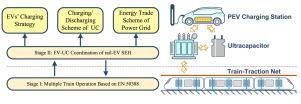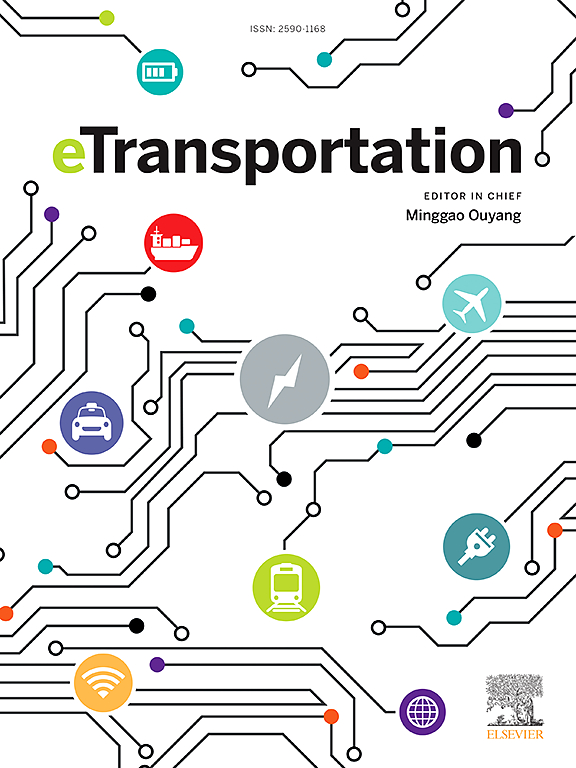提高市郊铁路的能源效率:铁路-电动汽车智能枢纽的两阶段调度优化
IF 17
1区 工程技术
Q1 ENERGY & FUELS
引用次数: 0
摘要
随着交通电气化革命的推进,市郊铁路和电动汽车(EV)的规模不断扩大,停车和乘车(P&R)设施作为市郊铁路牵引变压器和电动汽车充电站之间的关键能源耦合点,越来越受到重视。然而,如何灵活协调多列列车双向电力流与电动汽车充电需求之间的能量分配成为一个亟待解决的问题。本文建立了一个铁路-电动汽车智能能源枢纽(SEH)框架,将列车、超级电容器(UC)和基于电池的电动汽车整合在一起。本文提出了一个可修正的两阶段优化模型,使铁路能够提供 R2X(铁路到任何地方)服务。第一阶段确定最佳列车轨迹并调整时刻表,使多列列车的能耗最小化。在第二阶段,以第一阶段确定的列车功率流为输入,协调电动汽车的充电策略和 UC 的充放电方案。同时,铁路造成的电压不平衡将受到限制,以符合 IEC/TR 61000-3-13 规定的限制。基于中国实际市郊铁路线路的案例研究表明,所提出的调度优化方法可以显著降低铁路和电动汽车的能耗。本文章由计算机程序翻译,如有差异,请以英文原文为准。

Improving energy efficiency for suburban railways: A two-stage scheduling optimization in a rail-EV smart hub
As the scale of suburban rail and electric vehicles (EVs) continues to expand with the revolution of electrification of transportation, park and ride (P&R) facilities are increasingly recognized as critical energy coupling points between suburban rail traction transformers and EV charging stations. However, flexible coordination of the energy distribution among the bidirectional power flow of multiple trains and EVs’ charging demand becomes an urgent issue. In this paper, we establish a rail-EV Smart Energy Hub (SEH) framework integrating trains, ultra-capacitors (UC), and battery-based EVs. An emendable two-stage optimization model is proposed, enabling railways to provide R2X (railway-to-anything) services. The first stage determines the optimal train trajectory and adjusts timetables to minimize the energy consumption of multiple trains. In the second stage, the charging strategy of the EV is coordinated with the charging/discharging scheme of the UC, which takes the train power flow determined in the first stage as input. Meanwhile, the voltage unbalance caused by the railway is constrained to comply with the limits set by IEC/TR 61000-3-13. Case studies based on actual suburban railway lines in China demonstrate that the proposed scheduling optimization approach can significantly reduce the energy consumption of both railways and EVs.
求助全文
通过发布文献求助,成功后即可免费获取论文全文。
去求助
来源期刊

Etransportation
Engineering-Automotive Engineering
CiteScore
19.80
自引率
12.60%
发文量
57
审稿时长
39 days
期刊介绍:
eTransportation is a scholarly journal that aims to advance knowledge in the field of electric transportation. It focuses on all modes of transportation that utilize electricity as their primary source of energy, including electric vehicles, trains, ships, and aircraft. The journal covers all stages of research, development, and testing of new technologies, systems, and devices related to electrical transportation.
The journal welcomes the use of simulation and analysis tools at the system, transport, or device level. Its primary emphasis is on the study of the electrical and electronic aspects of transportation systems. However, it also considers research on mechanical parts or subsystems of vehicles if there is a clear interaction with electrical or electronic equipment.
Please note that this journal excludes other aspects such as sociological, political, regulatory, or environmental factors from its scope.
 求助内容:
求助内容: 应助结果提醒方式:
应助结果提醒方式:


